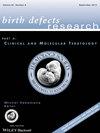下载PDF
{"title":"骨形态发生蛋白I型受体抑制诱导小鼠腭裂伴小颌畸形和下唇裂","authors":"Yongzhen Lai, Changfu Xie, Shixian Zhang, Guowu Gan, Di Wu, Weihui Chen","doi":"10.1002/bdra.23504","DOIUrl":null,"url":null,"abstract":"<div>\n \n <section>\n \n <h3> Background</h3>\n \n <p>Gain-of- and loss-of-function studies have demonstrated that changes in bone morphogenetic protein (BMP) signaling during embryo development cause craniofacial malformations, including cleft palate. It remains uncertain whether BMP signaling could be targeted pharmacologically to affect craniofacial morphogenesis.</p>\n </section>\n \n <section>\n \n <h3> Methods</h3>\n \n <p>Pregnant C57Bl/6J mice were treated with the BMP type I receptor inhibitor LDN-193189 at the dose of 3, 6, or 9 mg/kg twice a day by intraperitoneal injection from embryonic day 10.5 (E10.5) to E15.5. At E16.5, embryos were investigated by facial measurement analysis and histology to determine the optimal concentration for malformation. Subsequent embryonic phenotypes were analyzed in detail by histology, whole-mount skeletal staining, micro-computed tomography, and palatal organic culture. We further used immunohistochemistry to analyze protein expression of the BMP-mediated canonical and noncanonical signaling components.</p>\n </section>\n \n <section>\n \n <h3> Results</h3>\n \n <p>The optimal concentration of LDN-193189 was determined to be 6 mg/kg. In utero, LDN-193189 exposures induced partial clefting of the anterior palate or complete cleft palate, which was attributed to a reduced cell proliferation rate in the secondary palate, and delayed palatal elevation caused by micrognathia. Analysis of signal transduction in palatal shelves at E12.5 and E13.5 identified a significant reduction of BMP/Smad signaling (p-Smad1/5/8) and unchanged BMP noncanonical signaling (p-p38, p-Erk1/2) after treatment with LDN-193189.</p>\n </section>\n \n <section>\n \n <h3> Conclusion</h3>\n \n <p>The results of this study indicate that LDN-193189 can be used to manipulate BMP signaling by selectively targeting the BMP/Smad signaling pathway to affect palatal morphogenesis and produce phenotypes mimicking those caused by genetic mutations. This work established a novel mouse model for teratogen-induced cleft palate. Birth Defects Research (Part A) 106:612–623, 2016. © 2016 Wiley Periodicals, Inc.</p>\n </section>\n </div>","PeriodicalId":8983,"journal":{"name":"Birth defects research. Part A, Clinical and molecular teratology","volume":"106 7","pages":"612-623"},"PeriodicalIF":0.0000,"publicationDate":"2016-05-06","publicationTypes":"Journal Article","fieldsOfStudy":null,"isOpenAccess":false,"openAccessPdf":"https://sci-hub-pdf.com/10.1002/bdra.23504","citationCount":"6","resultStr":"{\"title\":\"Bone morphogenetic protein type I receptor inhibition induces cleft palate associated with micrognathia and cleft lower lip in mice\",\"authors\":\"Yongzhen Lai, Changfu Xie, Shixian Zhang, Guowu Gan, Di Wu, Weihui Chen\",\"doi\":\"10.1002/bdra.23504\",\"DOIUrl\":null,\"url\":null,\"abstract\":\"<div>\\n \\n <section>\\n \\n <h3> Background</h3>\\n \\n <p>Gain-of- and loss-of-function studies have demonstrated that changes in bone morphogenetic protein (BMP) signaling during embryo development cause craniofacial malformations, including cleft palate. It remains uncertain whether BMP signaling could be targeted pharmacologically to affect craniofacial morphogenesis.</p>\\n </section>\\n \\n <section>\\n \\n <h3> Methods</h3>\\n \\n <p>Pregnant C57Bl/6J mice were treated with the BMP type I receptor inhibitor LDN-193189 at the dose of 3, 6, or 9 mg/kg twice a day by intraperitoneal injection from embryonic day 10.5 (E10.5) to E15.5. At E16.5, embryos were investigated by facial measurement analysis and histology to determine the optimal concentration for malformation. Subsequent embryonic phenotypes were analyzed in detail by histology, whole-mount skeletal staining, micro-computed tomography, and palatal organic culture. We further used immunohistochemistry to analyze protein expression of the BMP-mediated canonical and noncanonical signaling components.</p>\\n </section>\\n \\n <section>\\n \\n <h3> Results</h3>\\n \\n <p>The optimal concentration of LDN-193189 was determined to be 6 mg/kg. In utero, LDN-193189 exposures induced partial clefting of the anterior palate or complete cleft palate, which was attributed to a reduced cell proliferation rate in the secondary palate, and delayed palatal elevation caused by micrognathia. Analysis of signal transduction in palatal shelves at E12.5 and E13.5 identified a significant reduction of BMP/Smad signaling (p-Smad1/5/8) and unchanged BMP noncanonical signaling (p-p38, p-Erk1/2) after treatment with LDN-193189.</p>\\n </section>\\n \\n <section>\\n \\n <h3> Conclusion</h3>\\n \\n <p>The results of this study indicate that LDN-193189 can be used to manipulate BMP signaling by selectively targeting the BMP/Smad signaling pathway to affect palatal morphogenesis and produce phenotypes mimicking those caused by genetic mutations. This work established a novel mouse model for teratogen-induced cleft palate. Birth Defects Research (Part A) 106:612–623, 2016. © 2016 Wiley Periodicals, Inc.</p>\\n </section>\\n </div>\",\"PeriodicalId\":8983,\"journal\":{\"name\":\"Birth defects research. Part A, Clinical and molecular teratology\",\"volume\":\"106 7\",\"pages\":\"612-623\"},\"PeriodicalIF\":0.0000,\"publicationDate\":\"2016-05-06\",\"publicationTypes\":\"Journal Article\",\"fieldsOfStudy\":null,\"isOpenAccess\":false,\"openAccessPdf\":\"https://sci-hub-pdf.com/10.1002/bdra.23504\",\"citationCount\":\"6\",\"resultStr\":null,\"platform\":\"Semanticscholar\",\"paperid\":null,\"PeriodicalName\":\"Birth defects research. Part A, Clinical and molecular teratology\",\"FirstCategoryId\":\"1085\",\"ListUrlMain\":\"https://onlinelibrary.wiley.com/doi/10.1002/bdra.23504\",\"RegionNum\":0,\"RegionCategory\":null,\"ArticlePicture\":[],\"TitleCN\":null,\"AbstractTextCN\":null,\"PMCID\":null,\"EPubDate\":\"\",\"PubModel\":\"\",\"JCR\":\"Q\",\"JCRName\":\"Medicine\",\"Score\":null,\"Total\":0}","platform":"Semanticscholar","paperid":null,"PeriodicalName":"Birth defects research. Part A, Clinical and molecular teratology","FirstCategoryId":"1085","ListUrlMain":"https://onlinelibrary.wiley.com/doi/10.1002/bdra.23504","RegionNum":0,"RegionCategory":null,"ArticlePicture":[],"TitleCN":null,"AbstractTextCN":null,"PMCID":null,"EPubDate":"","PubModel":"","JCR":"Q","JCRName":"Medicine","Score":null,"Total":0}
引用次数: 6
引用
批量引用

 求助内容:
求助内容: 应助结果提醒方式:
应助结果提醒方式:


